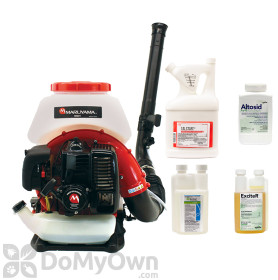Get Rid of Mosquitoes In Three Steps
Eliminate Standing Water Sources
Remove Spots Where Mosquitoes Breed & Lay Eggs
Trees and bushes should be kept pruned and grass should be kept short to limit resting areas for adult mosquitoes.
Other yard debris that is gathered in shady areas and that can retain moisture should be removed from your yard.
Use a Mosquito Larvicide
How to Kill Mosquito Larvae

Products needed for Step 2
Treat Yard With Mosquito Spray
Be sure you are getting the spray to the underside of the leaves on the foliage you are treating. Simply spraying the tops of the leaves will not be effective.
If you are located in an area where the mosquito population is especially high we strongly recommend you add an insect growth regulator to your insecticide spray solution. Insect growth regulators help sterilize the mosquitoes and make some eggs inviable. The addition of the insect growth regulator can also reduce how often you need to reapply products to once every 60 days as the reproduction cycle of the surrounding mosquitoes will have been interrupted.DoMyOwn.com has put together multiple mosquito control kits to make picking the right products easy for you and your specific needs.
Pro Tip
If you are planning an outdoor party or other outdoor event on your property you can add a pyrethrin based concentrated insecticide to your regular insecticide solution. The addition of a pyrethrin will offer two benefits:
- Pyrethrin offers a very fast knockdown which means you will see very quick results
- Pyrethrin based insecticides offer a short term repellency to keep mosquitoes and other annoying insects away from the treated areas.
You should resist the urge to coat your entire yard and home with the insecticide spray application. Doing this will reduce the mosquito population but it will also reduce the beneficial and predatory insects on your property. Reducing the beneficial and predatory insects could allow pest insects to move in after time.












